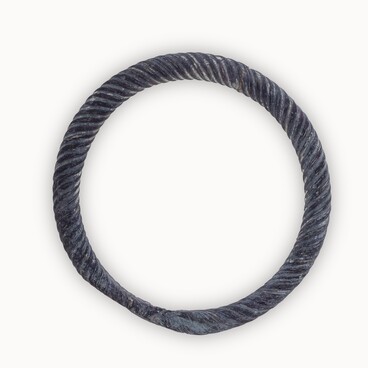A fragment of an icon of Saints Boris and Gleb was found during excavations of the Ratsky settlement (the Kursk region) in 1990. The piece was made of a lead-tin alloy by casting in a one-sided mold. Only the left side, bent in half, has been preserved from the entire piece. The upper and lower parts of the icon are lost.
The surviving part of the icon depicts, in accordance with the iconographic canons, the eldest of the holy brothers, Boris.
Boris and his brother Gleb were Russian princes, sons of the Kiev grand prince Vladimir Svyatoslavovich. In the internecine struggle that broke out in 1015 after the death of their father, they were killed by their elder brother Svyatopolk. Boris and Gleb became the first Russian saints, and they were canonized as martyrs, making them patrons of the Russian land and “heavenly helpers” of Russian princes. The saint on the left fragment of the icon holds a cross with rounded ends in his right hand. On his shoulders is a korzno (a cloak of princes and nobles of Kievan Rus’), fastened with a clasp on the right shoulder.
It can be stated with great certainty that the fragment of the Ratsky icon shows a scaled iron armor under Boris’s korzno. This kind of protective element is well known in the Old Russian iconography and is confirmed by the archaeological finds dating to the second half of the 1940s. To date, the number of identified parts of plate armor amounts to dozens of pieces. Another element of protective armor, an arm protector, can be seen in the right hand of the saint.
Also, at the left side of Prince Boris there is a sword, the scabbard of which has two transversal protrusions. It is very probable that these elements are a reflection of the straps of the cross-belt. The sword itself has sufficiently clear morphological signs. Blade weapons of this type, according to the typology of the expert on ancient weapons Anatoly Kirpichnikov, appear on the territory of Russia in the early 12th century. There is only one known sword of similar type in the modern Kursk region. It is housed in the Dmitriev Museum in the Kursk region. Of all the items of personal piety, synchronous in time with the image of Saint Princes Boris and Gleb, (first half of the 13th century) this fragment from the excavations of the Ratsk fortress is the only one with such a large number of protective equipment and weapons.
The surviving part of the icon depicts, in accordance with the iconographic canons, the eldest of the holy brothers, Boris.
Boris and his brother Gleb were Russian princes, sons of the Kiev grand prince Vladimir Svyatoslavovich. In the internecine struggle that broke out in 1015 after the death of their father, they were killed by their elder brother Svyatopolk. Boris and Gleb became the first Russian saints, and they were canonized as martyrs, making them patrons of the Russian land and “heavenly helpers” of Russian princes. The saint on the left fragment of the icon holds a cross with rounded ends in his right hand. On his shoulders is a korzno (a cloak of princes and nobles of Kievan Rus’), fastened with a clasp on the right shoulder.
It can be stated with great certainty that the fragment of the Ratsky icon shows a scaled iron armor under Boris’s korzno. This kind of protective element is well known in the Old Russian iconography and is confirmed by the archaeological finds dating to the second half of the 1940s. To date, the number of identified parts of plate armor amounts to dozens of pieces. Another element of protective armor, an arm protector, can be seen in the right hand of the saint.
Also, at the left side of Prince Boris there is a sword, the scabbard of which has two transversal protrusions. It is very probable that these elements are a reflection of the straps of the cross-belt. The sword itself has sufficiently clear morphological signs. Blade weapons of this type, according to the typology of the expert on ancient weapons Anatoly Kirpichnikov, appear on the territory of Russia in the early 12th century. There is only one known sword of similar type in the modern Kursk region. It is housed in the Dmitriev Museum in the Kursk region. Of all the items of personal piety, synchronous in time with the image of Saint Princes Boris and Gleb, (first half of the 13th century) this fragment from the excavations of the Ratsk fortress is the only one with such a large number of protective equipment and weapons.




